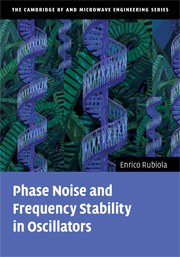Book contents
- Frontmatter
- Contents
- Foreword by Lute Maleki
- Foreword by David Leeson
- Preface
- Notation
- 1 Phase noise and frequency stability
- 2 Phase noise in semiconductors and amplifiers
- 3 Heuristic approach to the Leeson effect
- 4 Phase noise and feedback theory
- 5 Noise in delay-line oscillators and lasers
- 6 Oscillator hacking
- Appendix A Laplace transforms
- References
- Index
4 - Phase noise and feedback theory
Published online by Cambridge University Press: 24 January 2011
- Frontmatter
- Contents
- Foreword by Lute Maleki
- Foreword by David Leeson
- Preface
- Notation
- 1 Phase noise and frequency stability
- 2 Phase noise in semiconductors and amplifiers
- 3 Heuristic approach to the Leeson effect
- 4 Phase noise and feedback theory
- 5 Noise in delay-line oscillators and lasers
- 6 Oscillator hacking
- Appendix A Laplace transforms
- References
- Index
Summary
The main purpose of this chapter is to prove and generalize the Leeson formula (3.19), which was obtained with heuristic reasoning in Chapter 3. This extension in our knowledge suggests new simulation and experimental techniques and enables the analysis of other cases of interest not considered in the current literature, such as mode degeneracy or quasi-degeneracy in resonators or in an oscillator pulled off the resonant frequency. The analysis of delay-line oscillators and lasers in Chapter 5 is based on the ideas introduced here.
Before tackling this proof, however, we must build up a set of tools to manipulate the oscillator phase noise using Laplace transforms and the general formalism of linear time-invariant systems. The underlying idea is to represent the oscillator as a noise-free system that accepts a phase noise Ψ(s) at the input and delivers a phase noise Φ(s) at the output, as shown in Fig. 4.1. In this way the oscillator may be described by its phasenoise transfer function. The input noise, of course, is the noise of the oscillator's internal parts. The use of a Laplace transform to analyze the phase fluctuation of a sinusoidal signal is inspired by the field of phase-locked loops (PLLs), where it is a common way of calculating the transient response. However, this powerful approach constitutes a new departure in the noise analysis of oscillators.
- Type
- Chapter
- Information
- Phase Noise and Frequency Stability in Oscillators , pp. 88 - 124Publisher: Cambridge University PressPrint publication year: 2008

